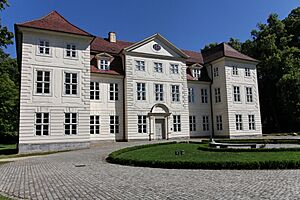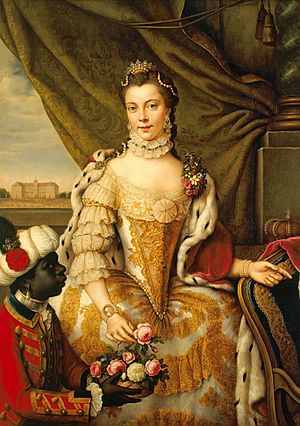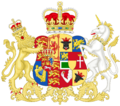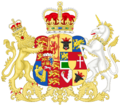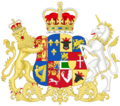Charlotte of Mecklenburg-Strelitz facts for kids
Charlotte of Mecklenburg-Strelitz (born Sophia Charlotte; May 19, 1744 – November 17, 1818) was the Queen of Great Britain and Ireland. She was the wife of George III from their marriage in 1761 until her death in 1818. She was also the Electress, and later Queen, of Hanover. Charlotte served as queen for 57 years, making her Britain's longest-serving queen consort.
Charlotte was born into the ruling family of Mecklenburg-Strelitz, a small German duchy. In 1760, George III became the King of Britain. He chose Charlotte as his wife because she was a minor German princess who was not interested in politics. They married in 1761. Their marriage lasted 57 years and they had 15 children. Among their children were two future British kings, George IV and William IV.
Queen Charlotte loved the arts and was interested in plants. She helped make Kew Gardens bigger and better. She is also famous for bringing the Christmas tree tradition to Britain. She decorated a Christmas tree for a children's party in 1800. Charlotte was very worried by her husband's serious illness, which became permanent later in his life. She was also close friends with Queen Marie Antoinette of France. The French Revolution made her feel even more stressed.
In 1811, her oldest son, George, became prince regent because the King's illness was so severe. Queen Charlotte died in November 1818 with her son George by her side. King George III died a little over a year later, likely without knowing his wife had passed away.
Contents
Early Life of Queen Charlotte
Sophia Charlotte was born on May 19, 1744. She was the youngest daughter of Duke Charles Louis Frederick of Mecklenburg, Prince of Mirow and his wife Princess Elisabeth Albertine of Saxe-Hildburghausen. Her home, Mecklenburg-Strelitz, was a small German duchy within the Holy Roman Empire.
Charlotte and her siblings were all born at the Lower Castle (Unteres Schloss) in Mirow. When she became engaged to King George III in 1761, reports said she had a "very mediocre education." Her schooling was similar to that of a daughter from a wealthy English country family. She learned some botany, natural history, and languages from tutors. However, her main focus was on managing a household and religious studies. She only experienced royal duties and court life after her brother, Adolphus Frederick, became the Duke in 1752.
Marriage to King George III
When George III became King of Great Britain, he was 22 years old and not married. His mother and advisors wanted him to marry soon. Princess Charlotte of Mecklenburg-Strelitz, who was 17, was a good choice for him. She came from a small German duchy and was not expected to be interested in politics. After they married, the King told her "not to meddle" in politics, which she was happy to follow.
In July 1761, the King announced his plan to marry Princess Charlotte. A group of escorts traveled to Germany to bring her to England. They arrived in Strelitz on August 14, 1761. Charlotte's brother, Duke Adolphus Frederick IV, signed the marriage contract. After three days of celebrations, Charlotte left for Britain on August 17, 1761.
Her sea journey was very difficult, as they faced three storms. They finally landed in Harwich on September 7. They traveled to London and arrived at St James's Palace on September 8. The King and his family met her at the garden gate. This was the first time the bride and groom met.
That same evening, just hours after her arrival, Charlotte married King George III. The ceremony took place at the Chapel Royal in St. James's Palace. Only the royal family, the German escort party, and a few guests were there.
Life as Queen Consort
Upon her wedding day, Charlotte did not speak English. However, she quickly learned the language, though she kept a strong German accent. People noted that she was shy at first but talked a lot once she knew people well.

Less than a year after their marriage, on August 12, 1762, Queen Charlotte gave birth to her first child, George, Prince of Wales. Over their marriage, they had 15 children. All but two of them (Octavius and Alfred) lived to be adults.
St James's Palace was the official home for the royal couple. However, the King had bought Buckingham House nearby. This new property was more private and surrounded by parkland. Around 1762, the King and Queen moved there as a private retreat. The Queen loved this home so much that it became known as The Queen's House. Most of their 15 children were born there. St James's Palace remained the official royal residence for ceremonies.
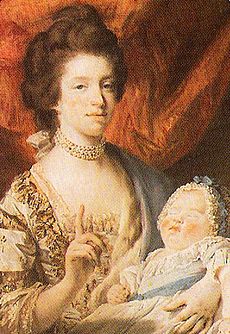
In her early years in Britain, Charlotte found it hard to get used to court life. Her mother-in-law, Augusta, made things difficult. Augusta insisted on strict court rules and appointed many of Charlotte's staff. Some of these staff members were expected to report on Charlotte's actions to Augusta. Charlotte found comfort and friendship with her German companions, especially her close friend Juliane von Schwellenberg.
The King enjoyed outdoor activities and preferred to live in the countryside near Kew and Richmond. He liked a relaxed family life, which surprised some courtiers who were used to grand displays.
From 1778, the royal family spent much time at the Queen's Lodge at Windsor. This new home was opposite Windsor Castle. The Queen was in charge of decorating the inside of their new residence. A friend described it as "dazzling," with beautiful Indian wallpaper and colorful furniture.
Charlotte was kind to her children's helpers. She once wrote a sweet note to her daughters' assistant governess, Miss Hamilton, thanking her for introducing her to a favorite poem.
Charlotte had some influence on political matters through the King. Her influence was quiet and indirect. She used her closeness with George III to stay informed and suggest people for jobs. She was especially interested in German issues. She cared about the War of the Bavarian Succession (1778–1779). It is thought that she encouraged the King to support British involvement in a conflict in 1785.
King George III's Illness
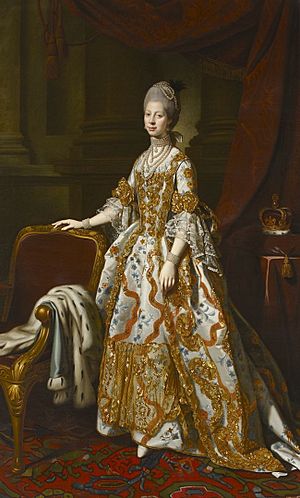
When the King first became unwell in 1765, Charlotte was not told about it. A law passed in 1765 said that if the King could no longer rule, Charlotte would become regent (ruler in his place). But since his illness was temporary, she didn't know about it or the law.
The King's serious illness in 1788 greatly worried and scared the Queen. She was heard asking, "What will become of me?" When the King collapsed one night, she insisted on having her own bedroom. She also insisted on going with him when he was moved to Kew. However, she and her daughters lived separately from him during his illness. They visited him often, but these visits were sometimes difficult because he would hold onto them and not let go.
During the King's 1788 illness, there was a disagreement between the Queen and her eldest son, the Prince of Wales. Both were considered for the role of regent if the King could no longer rule. The Queen was worried her son might try to have the King declared unable to rule. The Prince of Wales's supporters, in turn, worried the Queen might try to get herself appointed regent.
In 1789, a new law stated that the Prince of Wales would be regent if the King became permanently unwell. But it also put the King, his court, and his younger children under the Queen's care. The Queen used this power to stop the Prince of Wales from seeing the King alone, even after the King was declared better in 1789. This disagreement caused serious problems between them. They eventually made up in 1791.
As the King's illness became permanent, the Queen's personality changed. She became more easily upset and sad. She no longer enjoyed public events, even the music concerts she loved. Her relationships with her adult children also became difficult. From 1792, she found some comfort by planning the gardens and decoration of a new home for herself, Frogmore House, near Windsor.
From 1804 onwards, as the King's health declined, Queen Charlotte slept in a separate room and ate her meals apart from him. She avoided seeing him alone.
Interests and Royal Support
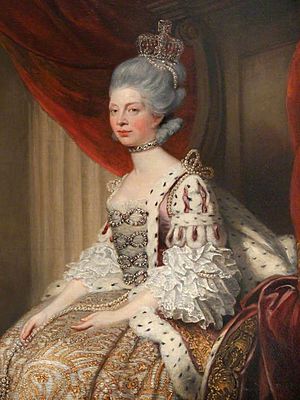
King George III and Queen Charlotte loved music, especially German composers. They greatly admired the music of George Frideric Handel.
In 1764, Wolfgang Amadeus Mozart, who was only eight years old, visited Britain with his family. The Mozarts were invited to play music at court. Johann Christian Bach, a famous musician, was the Queen's music teacher. He gave young Mozart difficult pieces to play, and Mozart played them perfectly without practicing. Mozart also played the flute and accompanied the Queen while she sang. The Queen was so impressed that she gave Mozart 50 guineas (a type of money) for his talent.
Queen Charlotte was interested in plants and loved Kew Gardens. During a time when explorers like Captain James Cook and Sir Joseph Banks were bringing back new plants from around the world, she made sure the gardens grew and added many new species. Because of her interest, a beautiful South African flower, the bird of paradise, was named Strelitzia reginae in her honor.
Queen Charlotte is also known for bringing the Christmas tree tradition to Britain. At first, she decorated a single yew branch, a common tradition in her home country of Mecklenburg-Strelitz. She would decorate it with her ladies-in-waiting, and then the court would sing carols and exchange gifts. In December 1800, Queen Charlotte set up the first known English Christmas tree at Queen's Lodge, Windsor. She held a big Christmas party for children from Windsor and put a whole tree in the drawing-room. It was decorated with tinsel, glass ornaments, fruits, and small wax candles. A guest described how children received sweets and toys from the tree. This tradition of decorating a tree became popular among the wealthy British families and later spread to other countries.
The royal couple supported many artists and craftspeople. These included cabinetmaker William Vile and painter Johann Zoffany. Zoffany often painted the King, Queen, and their children in relaxed, informal scenes. In 1788, the King and Queen visited the Worcester Porcelain Factory. Queen Charlotte ordered a special porcelain set, which was later named "Royal Lily" in her honor. Another porcelain design named after her was the "Queen Charlotte" pattern.
The Queen also helped found orphanages. In 1809, she became a supporter of the General Lying-in Hospital, a hospital for pregnant women. It was later renamed the Queen's Hospital, and today it is called Queen Charlotte's and Chelsea Hospital. She believed that women should be well-educated. She made sure her daughters received a better education than was common for young women at the time. However, she also kept her daughters close to her and did not allow them to marry until they were older.
Before 1788, portraits of Charlotte often showed her looking young and happy with her children. But in 1788, her husband became seriously ill. After this, her portraits showed her looking much older. One of her attendants wrote that the Queen was "much changed, her hair quite grey."
Friendship with Marie Antoinette
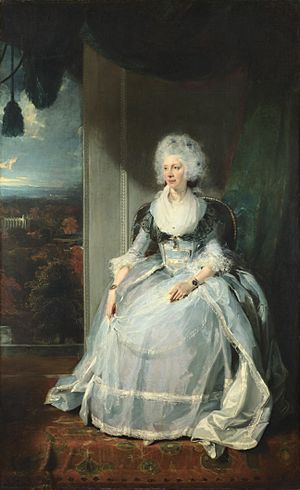
The French Revolution of 1789 likely added to the stress Charlotte felt. Queen Charlotte and Queen Marie Antoinette of France were close friends. Charlotte was 11 years older, but they shared many interests, like their love for music and art. They never met in person, but they wrote many letters to each other. Marie Antoinette told Charlotte about the problems in France when the revolution began. Charlotte even prepared rooms for the French royal family if they needed to escape to Britain.
Charlotte was very upset when she heard that the King and Queen of France had been executed.
During the Regency Period
After King George III's illness became permanent in 1811, his wife, Queen Charlotte, became his legal guardian. This was according to the Regency Bill of 1789.
She found it difficult to visit him often because of his unpredictable behavior. It is believed she did not visit him after June 1812. However, Charlotte continued to support her husband as his illness worsened. While her son, the Prince Regent, held the royal power, she remained her husband's guardian until her death in 1818. Because of the King's severe illness, he was not able to understand that she had died.
During her son's time as Prince Regent, Queen Charlotte continued to act as the main royal lady. This was because the Prince Regent and his wife were not getting along. So, Charlotte hosted official events with her son. For example, she was the hostess for the celebrations in London in 1814 when Emperor Napoleon was defeated. She also oversaw the upbringing of her granddaughter, Princess Charlotte of Wales.
Death of Queen Charlotte

Queen Charlotte died at the family's country home, Dutch House in Surrey (now Kew Palace). Her eldest son, the Prince Regent, was holding her hand as she sat in an armchair. She was buried at St George's Chapel, Windsor Castle. Her husband, King George III, died just over a year later.
Charlotte was the longest-serving queen consort in British history. She served for 57 years and 70 days, from her marriage on September 8, 1761, until her death on November 17, 1818.
The day before she died, the Queen wrote her will. Her personal belongings were valued at less than £140,000. Her jewels made up most of her wealth. In her will, she left her husband the jewels he had given her. If he remained unwell, these jewels would become a family treasure for the House of Hanover. Other jewels were to be divided equally among her surviving daughters. Her youngest daughter, Sophia, inherited the Royal Lodge.
After the Queen's death, her eldest son, the Prince Regent, claimed Charlotte's jewels. When he died, his heir, William IV, claimed them. This led to a long disagreement between her granddaughter Queen Victoria and Charlotte's son Ernest. The dispute was finally settled in 1858, in favor of Ernest's son George.
The rest of Charlotte's belongings were sold at auction from May to August 1819. Her clothes, furniture, and even her snuff were sold. It is very unlikely that her husband ever knew she had died. He passed away 14 months later, blind, deaf, and unwell.
Queen Charlotte's Legacy
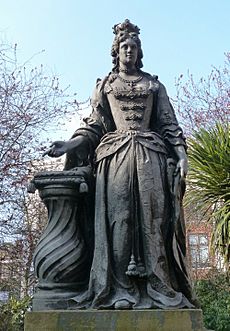
Many places around the world are named after Queen Charlotte. These include the Queen Charlotte Islands (now called Haida Gwaii) in British Columbia, Canada. There is also Queen Charlotte City on Haida Gwaii, and Queen Charlotte Sound. In New Zealand, there is Queen Charlotte Sound / Tōtaranui. Several forts, like Fort Charlotte, Saint Vincent, are named after her.
Cities and counties in the United States also bear her name, such as Charlottesville, Virginia; Charlotte, North Carolina; Mecklenburg County, North Carolina; and Charlotte County, Florida. In Tonga, the royal family adopted the name Sālote (the Tongan version of Charlotte) in her honor.
Queen Charlotte's financial support prevented the closure of the General Lying-in Hospital in London. Today, it is known as Queen Charlotte's and Chelsea Hospital and is a leading maternity hospital. A large portrait of Queen Charlotte hangs in the hospital's main lobby. The Queen Charlotte's Ball, an annual event that originally raised money for the hospital, is also named after her.
A lead statue, likely of Queen Charlotte, stands in Queen Square in London. There are also two statues of her in Charlotte, North Carolina.
Rutgers, The State University of New Jersey, was founded in 1766 as Queen's College, named after Queen Charlotte. Its oldest building, Old Queen's, and the historic part of the university, Queen's Campus, still keep their original names.
Queen Charlotte has been played by actresses in several TV shows and movies. These include Frances White in Prince Regent (1979), Helen Mirren in The Madness of King George (1994), Golda Rosheuvel in Bridgerton (2020), and India Amarteifio in Queen Charlotte: A Bridgerton Story.
The beautiful flowering plant Strelitzia, also known as the bird of paradise flower, is named after Charlotte's home region, Mecklenburg-Strelitz.
Issue
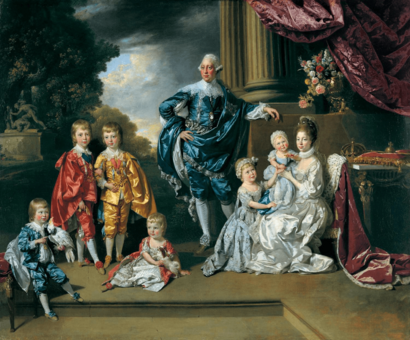
| Name | Birth | Death | Notes |
|---|---|---|---|
| George IV | 12 August 1762 | 26 June 1830 | Married Princess Caroline of Brunswick-Wolfenbüttel; had one daughter, Princess Charlotte of Wales. |
| Prince Frederick, Duke of York and Albany | 16 August 1763 | 5 January 1827 | Married Princess Frederica of Prussia; no children. |
| William IV | 21 August 1765 | 20 June 1837 | Married Princess Adelaide of Saxe-Meiningen; no surviving children. |
| Charlotte, Princess Royal | 29 September 1766 | 6 October 1828 | Married King Frederick of Württemberg; no surviving children. |
| Prince Edward, Duke of Kent and Strathearn | 2 November 1767 | 23 January 1820 | Married Princess Victoria of Saxe-Coburg-Saalfeld; had one daughter, Queen Victoria. |
| Princess Augusta Sophia | 8 November 1768 | 22 September 1840 | Never married, no children. |
| Princess Elizabeth | 22 May 1770 | 10 January 1840 | Married Frederick VI, Landgrave of Hesse-Homburg; no children. |
| Ernest Augustus, King of Hanover | 5 June 1771 | 18 November 1851 | Married Princess Friederike of Mecklenburg-Strelitz; had one son, King George V of Hanover. |
| Prince Augustus Frederick, Duke of Sussex | 27 January 1773 | 21 April 1843 | Married The Lady Augusta Murray (marriage later ended); later married The Lady Cecilia Buggin; no children from either marriage. |
| Prince Adolphus, Duke of Cambridge | 24 February 1774 | 8 July 1850 | Married Princess Augusta of Hesse-Kassel; had children. |
| Princess Mary | 25 April 1776 | 30 April 1857 | Married Prince William Frederick, Duke of Gloucester and Edinburgh; no children. |
| Princess Sophia | 3 November 1777 | 27 May 1848 | Never married, no children. |
| Prince Octavius | 23 February 1779 | 3 May 1783 | Died as a child. |
| Prince Alfred | 22 September 1780 | 20 August 1782 | Died as a child. |
| Princess Amelia | 7 August 1783 | 2 November 1810 | Never married, no children. |
Images for kids
-
Portrait of Queen Charlotte by Allan Ramsay, 1761
See also
 In Spanish: Carlota de Mecklemburgo-Strelitz para niños
In Spanish: Carlota de Mecklemburgo-Strelitz para niños




